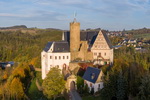It was built between 1546 and 1549 as a visible sign of wealth and social status by Wolf Hünerkopf. Was considerably enlarged in Renaissance style under Dietrich von Taube in the first half of the 17th century.
After the end of World War II, the castle housed Soviet soldiers for some time and then the Soviet command. After the army left, the castle became a rather strange labor camp, where “hard-to-educate” girls aged 14 to 18 from all over the GDR were sent. At the time, this meant that one did not fit into the socialist image of humanity. The girls in the castle initially worked mainly in agriculture, later in industry.
Since 1991, reconstruction began. In addition to the castle, there is a hotel, restaurants and art workshops on the grounds. The large courtyard facilitates exhibitions, cultural events, seasonal markets and open-air concerts.
The park around the castle.
Getting there: parking lot 50.769833, 12.891000. The Bf Neukirchen-Klaffenbach train station is 500 meters from the castle.












